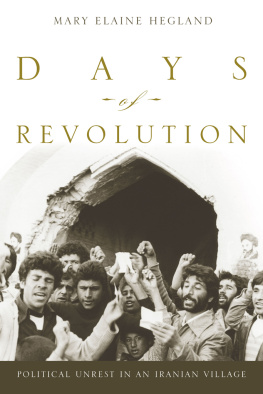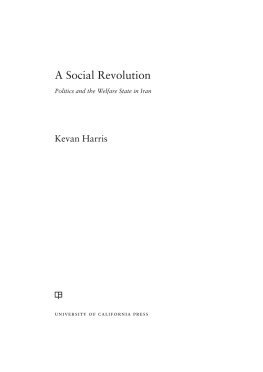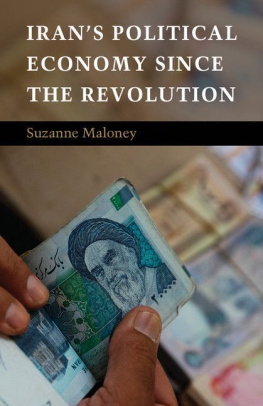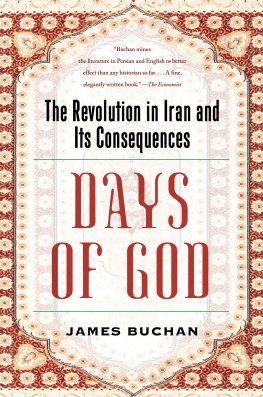Stanford University Press
Stanford, California
2014 by the Board of Trustees of the Leland Stanford Junior University. All rights reserved.
No part of this book may be reproduced or transmitted in any form or by any means, electronic or mechanical, including photocopying and recording, or in any information storage or retrieval system without the prior written permission of Stanford University Press.
Printed in the United States of America on acid-free, archival-quality paper
Library of Congress Cataloging-in-Publication Data
Hegland, Mary Elaine, author.
Days of revolution: political unrest in an Iranian village / Mary Elaine Hegland.
pages cm
Includes bibliographical references and index.
ISBN 978-0-8047-7567-0 (cloth: alk. paper)
ISBN 978-0-8047-7568-7 (pbk.: alk. paper)
1. VillagesIranCase studies. 2. Political cultureIran. 3. IranHistoryRevolution, 1979. 4. IranPolitics and government19791997. 5. IranPolitics and government1997- I. Title.
DS318.81.H44 2014
955'.72dc23
2013026629
ISBN 978-0-8047-8885-4 (electronic)
Typeset by Bruce Lundquist in 11/13.5 Adobe Garamond
Days of Revolution
Political Unrest in an Iranian Village
Mary Elaine Hegland
Stanford University Press
Stanford, California
With gratitude, in memory of
Rahmat Khanum
Shaikh Naser
Margaret Hegland
Norval Hegland
Richard Antoun
and with many thanks to the people of Aliabad
Illustrations
Maps
Figures
Preface
Researching a Revolution: 19781979
WHEN I FLEW TO IRAN IN JUNE 1978, I did not know I would be conducting field research about a revolution. My study was originally to have been about agricultural credit systems in rural Iran to shed light on processes of change in social, political and economic relations in an Iranian village. The ten prospective village fieldwork sites I visited near Shiraz, capital of the southwestern province of Fars, seemed to fall into three categories. Villages close to Shiraz demonstrated a new prosperity due to employment opportunities in and near the city. Other villages prospered due to land reform and mechanized agricultural irrigation. A third category of village was characterized by poverty and the absence of able-bodied men. These settlements had not benefited from land reform and were far enough away from Shiraz to prevent villagers from commuting for work. Men moved away to find work, leaving mainly the elderly and less able living in the home village.
In one of these latter settlements, my family and I and the two staff members from Shiraz University kind enough to escort us were served tea and watermelon in an open area among the ramshackle mudbrick homes. We ate, swatting away the many flies, watched quietly by barefoot children in tattered clothing who knew the treat was not for them. The little group of villagers talked with us about their need for water and the inequity of the land distribution. One slight old man (actually probably about 55) pleaded insistently with us to convey the villages needs to the provincial governor, to ask him to at least give them a paved road. The road to the nearby town was impassible during the rainy season because of thick mud. Women experiencing trouble in childbirth had died because they couldnt be brought to the town only a few kilometers away. I passed this plea on to the highest official I could, but with little hope of benefit.
In late summer we settled in Aliabad, a relatively prosperous village close to Shiraz. A bus line to the outskirts of the city meant my then-husband could get to Pahlavi University (now Shiraz University), where he had a Fulbright teaching position for the year. I was directed by the gendarmerie (rural police) office in Shiraz to present my letter of research permission to the captain of the Qodratabad gendarmerie station 2.2 kilometers (about 1.4 miles) from Aliabad. The captain took me to the home of Mashd for the first half of our period in the village. After the Revolution, when the gendarmes were no longer in control and in fact no center of control in Shiraz was effective, I felt free to change my residence to another courtyard. The second half of my stay I lived with neighbors sympathetic to the local uprising against Seyyid Yaqubs powerful brother, Seyyid Ibn Ali Askari.
Because I wished to conduct research in a village in the midst of changing economic relations, I had hoped to live in a smaller and more remote settlement, but Aliabad, with its history of political significance and conflict and many residents activism during the revolutionary period, turned out to be a fruitful site.
Aliabad was a village of some 3,000 then, a population in constant flux as villagers moved away and others returned. Many villagers came back from Shiraz and elsewhere to build urban-style homes in the new village across the highway from the old walled settlement. The convenient travel between Aliabad and Shiraz, as well as the nearby factories and construction sites, were among the reasons for the relative prosperity of residents. The plentiful availability of jobs in the late 1970s meant that few households in Aliabad were extremely needy. This relative economic prosperity resulted in a major research challenge for me. I could not find any girl living nearby whose family needed money enough to overcome the stigma against females working. Time available for interviewing was minimized and frequently interrupted while I gave attention to my still-nursing daughter and cared for my household. The 18-month grant, instead of the more typical 9-month research period, from the Social Science Research Council and the American Council of Learned Societies was all the more welcome to mea mother as well as a researcher.
In addition to its relatively large size and its prosperity resulting from close proximity to Shiraz, Aliabad was unusual in having facilities not ordinarily found in Iranian villages. Aliabad had been chosen by the national government to be somewhat of a model village and had water piped into many courtyards, piped natural gas, electricity, a full elementary school and a clinic.
In spite of the limiting and awkward position of living in the courtyard of the village boss, I attempted to get acquainted with villagers. Meeting the Askaris relatives and associates was not difficult. Rana, social leader of the informal group of seyyid women and wife of Seyyid Yaqubs nephew Seyyid Enayat Askari, soon became a friend. Rana hosted the meetings led by personnel from the conservative Religious School of Zahra in Shiraz. In the nearby courtyard of Seyyid Ayyub, Seyyid Yaqubs fathers brother, I became acquainted with Seyyid Ayyubs son Seyyid Kazem, a gifted political analyst, and with members of other households in the courtyard who in turn brought me into contact with still more relatives. Seyyid Ayyubs youngest daughter brought her nephew Hushang Amini, who attended Tehran University for a few months before it closed, to meet me. In this way, contact was established between me and Haidar Aminis family, several of whom proved to be important informants. This family was respected and connected to several village factions yet remained relatively neutral regarding the Revolution and the post-revolutionary uprising against Seyyid Ibn Ali Askari. Family members were well-informed about village history and current conflicts. Because of their status and political neutrality, they did not seem to fear negative results from association with the Americans. In retrospect, I suspect that the sight of Haidar Aminis son Behnam escorting the American family to his fathers home at dinner-time must have helped shield us in the sensitive period right after the Revolution. The family of Haidar Amini was one of the few families who continued to associate with us during that time.
Next page









